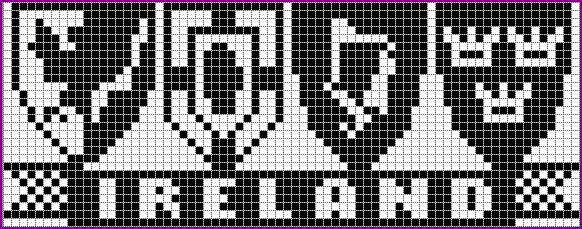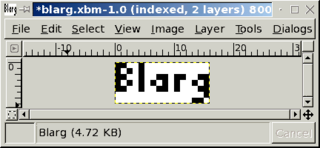This article needs additional citations for verification .(January 2017) |
OTA Bitmap was a specification designed by Nokia for black and white images for mobile phones.
This article needs additional citations for verification .(January 2017) |
OTA Bitmap was a specification designed by Nokia for black and white images for mobile phones.
The OTA or Over The Air Bitmap was defined by Nokia Corporation as part of their Smart Messaging Specification, to send pictures as a series of one or more concatenated SMS text messages. The format has a maximum size of 255x255 pixels. It is very rare for an OTA bitmap to measure anything other than 72x28 pixels (for Picture Messages) or 72x14/72x13 pixels (for Operator Logos). The specification contains a byte of data to be used for indicating a multicolour image. This was to future-proof the standard, but the advent of Multimedia Messaging meant it never got to implementation.
The OTA Bitmap format is a monochrome, uncompressed format using one bit per pixel. As the format was designed for cellular phones, there is no standard computer format. It may be stored as a binary file or as hex (usually without spaces) in a text file. Recognized extension is .otb.
This format is the Copyright of Nokia Corporation.
Before the image itself there is a header. The header is four bytes wide. A typical example is: 00 48 1C 01. These are:
00 The 'Infofield' (always remains as 00). 48 The width of the bitmap, 72 pixels in this case (48 is hex for 72). 1C The height of the bitmap, 28 pixels in this case (1C is hex for 28). 01 The number of colours (always 1).
Other possibilities may be: 00 48 0E 01 (for 72x14 bitmaps), 00 48 0D 01 (for 72x13 bitmaps).
After the header the image itself starts. This example will use the following 72x28 pixel image.

The first 8 pixels, reading right from the top left hand corner are one white (0) followed by seven blacks (1111111), giving the first byte, in Binary, as 01111111.
Converting from the binary 01111111 to hex, results in the first byte that represents the pixels (7F). The next 8 characters are 8 blacks (11111111 or FF) and so on.
When all pixels from the top row are encoded, simply move to the next. There are no markers to indicate a new row, that information is contained in the header.
In the case of an OTA bitmap that is not a multiple of eight pixels in width, a single byte is used to convey information from two lines (e.g. two pixels from the first row and six from the second.) This is not the case in some other formats, so it is important to exercise care when converting between OTA and formats like WBMP.
Here is the result of the image converted to OTA.
00 48 1C 01 //Header 7F FF EF FF EF FF FB FF FE //First Row 40 3F E8 38 2F FF FB FF FE //Second Row 48 3F A8 38 2F 9F FB FF FE //Third Row 4C FF A9 FF 2F 8F FA DA DA //Fourth Row 4E FF 29 01 2F 80 FA 52 52 5E 7F 69 31 2F BF 7B 07 06 4F FF 69 79 2F BE FB 77 76 47 FF 69 79 2F BE 7B 07 06 47 FE EF 7D EF BE 7B FF FE 47 FC EF 7D E7 BC F1 FF FC 40 F0 EF 7D E7 7C F1 ED BC 21 E7 C9 79 27 98 F1 E5 3C 21 E7 C9 39 27 C8 F1 F0 7C 16 6F 89 39 23 E6 E0 F7 78 15 2F 88 82 23 F3 E0 F0 78 08 3F 04 44 43 D7 E0 FF F8 04 3E 02 28 81 EF C0 7F F0 02 3C 01 39 00 FF 80 3F E0 01 38 00 BA 00 7F 00 1F C0 00 F0 00 7C 00 3E 00 0F 80 FF C0 00 38 00 1C 00 07 FF 55 FF FF FF FF FF FF FF AA 2A F3 87 87 3F 1E 67 0F 54 15 F3 93 9F 3E 4E 27 27 A8 2A F3 87 8F 3E 4E 07 27 54 55 F3 93 9F 3E 0E 47 27 AA FF F3 9B 87 0E 4E 67 0F FF //Penultimate Row 00 FF FF FF FF FF FF FF 00 //Last Row
Note to review: there is no write support for OTA format in XnView

The Graphics Interchange Format is a bitmap image format that was developed by a team at the online services provider CompuServe led by American computer scientist Steve Wilhite and released on 15 June 1987. It is in widespread usage on the World Wide Web due to its wide support and portability between applications and operating systems.

Portable Network Graphics is a raster-graphics file format that supports lossless data compression. PNG was developed as an improved, non-patented replacement for Graphics Interchange Format (GIF) — unofficially, the initials PNG stood for the recursive acronym "PNG's not GIF".
PCX, standing for PiCture eXchange, was an image file format developed by the now-defunct ZSoft Corporation of Marietta, Georgia, United States. It was the native file format for PC Paintbrush and became one of the first widely accepted DOS imaging standards, although it has since been succeeded by more sophisticated image formats, such as BMP, JPEG, and PNG. PCX files commonly stored palette-indexed images ranging from 2 or 4 colors to 16 and 256 colors, although the format has been extended to record true-color (24-bit) images as well.
PackBits is a fast, simple lossless compression scheme for run-length encoding of data.

In computer graphics and digital photography, a raster graphic represents a two-dimensional picture as a rectangular matrix or grid of square pixels, viewable via a computer display, paper, or other display medium. A raster is technically characterized by the width and height of the image in pixels and by the number of bits per pixel. Raster images are stored in image files with varying dissemination, production, generation, and acquisition formats.
The JPEG File Interchange Format (JFIF) is an image file format standard published as ITU-T Recommendation T.871 and ISO/IEC 10918-5. It defines supplementary specifications for the container format that contains the image data encoded with the JPEG algorithm. The base specifications for a JPEG container format are defined in Annex B of the JPEG standard, known as JPEG Interchange Format (JIF). JFIF builds over JIF to solve some of JIF's limitations, including unnecessary complexity, component sample registration, resolution, aspect ratio, and color space. Because JFIF is not the original JPG standard, one might expect another mime-type. However, it is still registered as "image/jpeg".
The BMP file format, also known as bitmap image file, device independent bitmap (DIB) file format and bitmap, is a raster graphics image file format used to store bitmap digital images, independently of the display device, especially on Microsoft Windows and OS/2 operating systems.

RGBA stands for red green blue alpha. While it is sometimes described as a color space, it is actually a three-channel RGB color model supplemented with a fourth alpha channel. Alpha indicates how opaque each pixel is and allows an image to be combined over others using alpha compositing, with transparent areas and anti-aliasing of the edges of opaque regions.

Interleaved Bitmap (ILBM) is an image file format conforming to the Interchange File Format (IFF) standard. The format originated on the Amiga platform, and on IBM-compatible systems, files in this format or the related PBM format are typically encountered in games from late 1980s and early 1990s that were either Amiga ports or had their graphical assets designed on Amiga machines.
In computer programming, a magic number is any of the following:

In computer graphics, the X Window System used X BitMap (XBM), a plain text binary image format, for storing cursor and icon bitmaps used in the X GUI. The XBM format is superseded by XPM, which first appeared for X11 in 1989.
Netpbm is an open-source package of graphics programs and a programming library. It is used mainly in the Unix world, where one can find it included in all major open-source operating system distributions, but also works on Microsoft Windows, macOS, and other operating systems.
The ICO file format is an image file format for computer icons in Microsoft Windows. ICO files contain one or more small images at multiple sizes and color depths, such that they may be scaled appropriately. In Windows, all executables that display an icon to the user, on the desktop, in the Start Menu, or in Windows Explorer, must carry the icon in ICO format.
Intel hexadecimal object file format, Intel hex format or Intellec Hex is a file format that conveys binary information in ASCII text form. It is commonly used for programming microcontrollers, EPROMs, and other types of programmable logic devices and hardware emulators. In a typical application, a compiler or assembler converts a program's source code to machine code and outputs it into a HEX file. Some also use it as a container format holding packets of stream data. Common file extensions used for the resulting files are .HEX or .H86. The HEX file is then read by a programmer to write the machine code into a PROM or is transferred to the target system for loading and execution.
The Apple Icon Image format is an icon format used in Apple Inc.'s macOS. It supports icons of 16 × 16, 32 × 32, 48 × 48, 128 × 128, 256 × 256, 512 × 512 points at 1x and 2x scale, with both 1- and 8-bit alpha channels and multiple image states. The fixed-size icons can be scaled by the operating system and displayed at any intermediate size.

Motorola S-record is a file format, created by Motorola in the mid-1970s, that conveys binary information as hex values in ASCII text form. This file format may also be known as SRECORD, SREC, S19, S28, S37. It is commonly used for programming flash memory in microcontrollers, EPROMs, EEPROMs, and other types of programmable logic devices. In a typical application, a compiler or assembler converts a program's source code to machine code and outputs it into a HEX file. The HEX file is then imported by a programmer to "burn" the machine code into non-volatile memory, or is transferred to the target system for loading and execution.
Smart messaging is a proprietary service developed by Nokia used for the sending and receiving of various digital media via SMS.
In computing, a bitmap is a mapping from some domain to bits. It is also called a bit array or bitmap index.

GNU Unifont is a free Unicode bitmap font using an intermediate bitmapped font format created by Roman Czyborra. The main Unifont covers all of the Basic Multilingual Plane (BMP). The "upper" companion covers significant parts of the Supplementary Multilingual Plane (SMP). The "Unifont JP" companion contains Japanese kanji present in the JIS X 0213 character set.
The Quite OK Image Format (QOI) is a specification for lossless image compression of 24-bit or 32-bit color raster (bitmapped) images, invented by Dominic Szablewski and first announced November 24th 2021.